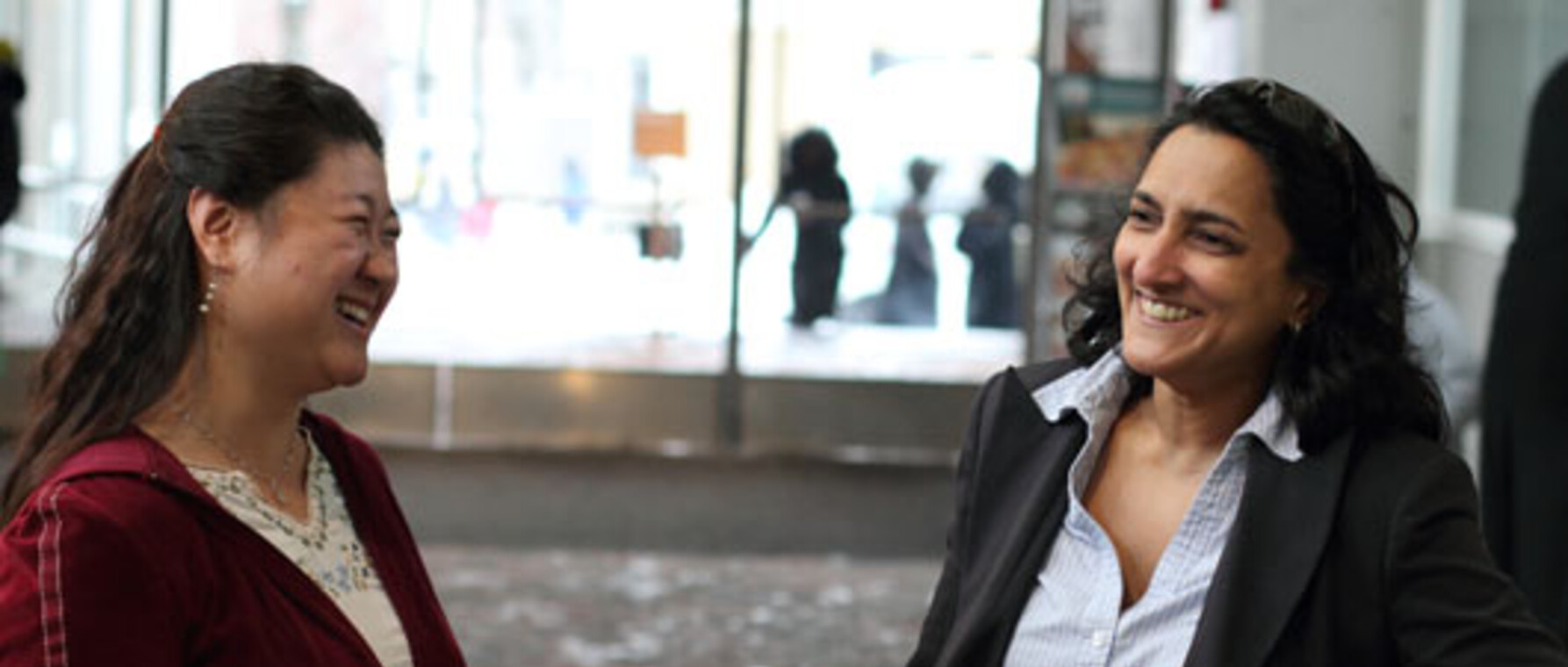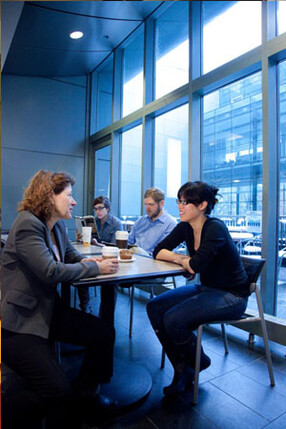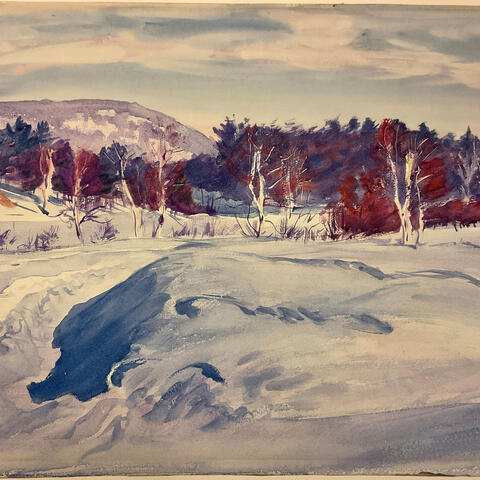The Big Picture, the Details, and Everything in Between
Student-run mentoring program helps women PhD candidates prepare for careers and lives in the sciences

Research at Risk: Since World War II, universities have worked with the federal government to create an innovation ecosystem that has yielded life-changing progress. Now much of that work may be halted as funding is withdrawn. Find out more about the threats to medical, engineering, and scientific research, as well as how Harvard is fighting to preserve this work—and the University's core values.
When Emily Gardel arrived at Harvard to start a PhD program in applied physics, she admits to experiencing “a bit of a culture shock.” Gardel had come out of an undergraduate physics major at Smith College, and the scale and tenor of life at GSAS made for a sharp contrast with all she remembered from her days in Northampton. “I felt like the interactions with students and faculty were very different,” she says. “I really missed the one-on-one interactions with professors.”
Gardel could have floundered, and her decision to change labs in her third year could have derailed her. Instead, she thrived. Five years into her program, she is the winner of an elite Department of Energy graduate fellowship that she’ll use to examine how bacteria can generate electricity. And she’s a co-chair of Harvard Graduate Women in Science and Engineering (HGWISE), a GSAS student organization that focuses on building a community for women scientists, helping them overcome precisely the kinds of challenges she experienced early on.
What got her over the hurdle? It’s reductive to point to any single factor, of course. And yet there is one thing that distinguishes her experience from that of any number of students who’ve struggled to find their place in graduate school: she has a mentor. And when it comes to women in the natural sciences, life sciences, and engineering sciences, that’s a key predictor of success, at all stages of the game.
Opening the pipeline
According to the 2010 annual report of the Office of the Senior Vice Provost for Faculty Development and Diversity, just over one-quarter (27%) of Harvard’s faculty are female — an all-time high. And for the first time in history, women comprise 22% of Harvard’s senior faculty.
There is wide disparity in the distribution of senior women, however. Despite gains elsewhere, percentages remain “stubbornly low across the sciences,” the report concludes, citing Engineering (9%), FAS Natural Sciences (14%), and the Medical Quad (15%), among other Harvard units.
Harvard is hardly alone in facing a problem in the pipeline that feeds senior-level positions in the sciences. And the University reports hopeful news in the junior faculty ranks, where women comprise 36 percent of the population, and where the percentages of women in the sciences are at or near all-time highs, including in FAS Natural Sciences (32%), the Medical Quad (34%), and Engineering (26%).
If part of the challenge is to make sure the pipeline runs more efficiently, part of the solution may lie in showing women scientists, early in their careers, what a life in academia can look like, and then supporting them on the way. Shortly after Harvard released findings from the 2005 Task Force on Women in Science and Engineering, which determined that the University had made “only limited progress in its efforts to create a genuinely diverse faculty,” HGWISE — formed that same year — took action on one of the report’s core recommendations: to enhance mentoring at all levels.
The HGWISE Mentoring Program, launched in 2008, matches PhD students with women faculty members across the scientific disciplines. It has seen demand for its services nearly triple in the three years of its existence; this year, 65 PhD students are participating in the program, meeting regularly in group or one-on-one sessions with one of 44 faculty members who’ve signed on as mentors.
“Women face a dearth of role models in many science and engineering fields,” says Carolyn Eng, a fourth-year PhD candidate in human evolutionary biology and the co-director of the Mentoring Program. “Women want to communicate with others in their fields, and our goal was to introduce them to faculty who are successful and who maintain a work/life balance, the latter of which can be challenging for female students. More than anything, this is an opportunity for women to meet and network with other scientists, and learn from those who have achieved success in the field before them.”
Heather Pon-Barry, a fifth-year PhD student in computer science and the other program co-director, says meeting with her mentor “gives me an understanding of the challenges I will face in my future.
“Being a PhD student can be an isolating experience,” Pon-Barry says. “The mentoring program helps you see the bigger picture. Participants may maintain their relationships for years. They often focus on long-range goals, whereas with advisors, you tend to focus on short-range plans.”
Conversations with HGWISE mentors and students reveal a mutually beneficial relationship built with equal parts commiseration and inspiration. Mentors say they become more attuned to the concerns of their own advisees and lab members. And students learn to envision a professional life that balances all of their interests, in the lab and beyond.
Lessons about perspective: Christine, Grace and Sheila
Christine Kiely and Ye Grace Chen joined the HGWISE mentoring program three years ago, and — in what proved a fortunate bit of happenstance — were matched with a young faculty member named Sheila Thomas. They’ve met regularly since then, and the friendship among the trio is instantly obvious.
“The three of us just really click,” says Chen, a fifth-year PhD student in chemical biology. “We are all at different places in our academic careers and have different mindsets. But we talk about everything — working in the lab, our daily lives, our goals, and our research.”
“She’s one of the most involved faculty members that I know,” says Kiely, now in the final stages of her PhD program in biological and biomedical sciences. Thomas is a cancer-cell biologist in the Department of Medicine at Harvard Medical School and Beth Israel Deaconess Medical Center. “She’s on so many committees and is really involved with students,” says Kiely. “You can tell she really cares about us and about our experience here. It’s great just to be able to watch her, as a role model, and see that it is possible to achieve at high levels and still be a well-rounded person.”
Chen agrees. “One of the most important lessons that I’ve learned from Sheila is about perspective,” she says. “As graduate students who spend many hours a day focused on a specific question or model, we sometimes get tunnel vision. Having conversations with Sheila and Christine helps me broaden my view and realize that I’m not the only person to ever experience these emotions — professors were graduate students once, too — and that communicating clearly can help prevent misunderstandings.”
“Mentoring is part of my scientific upbringing,” says Thomas, who directs diversity programs at the Division of Medical Sciences (the joint PhD program of GSAS and HMS), and who recently became assistant dean for diversity and minority affairs at GSAS. “I’ve had great mentors all along the way, and I wouldn’t be where I am without them. None of us did this alone.”
Modeling confidence: Eun Young and Jesse
In a conversation that ranges widely over issues of science, gender, self-confidence, and career-building, Eun Young Choi and her mentor, Jesse Snedeker, seem to delight in their easy rapport. Both women are honest and reflective, confident enough to discuss the challenges and doubts that go along with the life’s work they have chosen.

“The most valuable thing I received from this relationship is that Jesse became a role model of someone who is quite different from me in outward behavior — assertive and confident in her actions and thoughts,” says Choi, a fifth-year PhD candidate in neuroscience, who was one of two founders of the HGWISE Mentoring Program. “She is an example of someone who simply lives without the doubts that I have, so it was valuable to me to see this completely different perspective. It’s made me consider that there is another way of thinking.”
“I don’t know that I don’t have doubts,” replies Snedeker, a professor of psychology, with a smile. “I might have different doubts at this stage in my career. But everyone needs multiple perspectives, because there is no one right way to do this. You need the ability to look across different solutions to the problems you’re facing, because there are many different ways that people combine their work and their life, and there are many different ways that they organize a research program.”
Snedeker says she joined the Mentoring Program to pay back the support she received at critical junctures in her career, such as when she decided to have a child during her second year in graduate school. “But I’m much more aware of what I get out of the situation. This has made me a much better graduate advisor. It has made me aware of things I had not considered before.”
She’s come to see, for instance, that “there are work-life balance issues when you’re 25,” even if they may be less perceptible to senior faculty members years removed from that time in their own lives. “Graduate students who are just starting to build their research programs are often at a loss for how to cram in eating actual meals, getting some reasonable degree of exercise, keeping track of their families, who live 200 or 2,000 miles away, and getting the work done,” she says. “Those are very real work-life balance issues.”
Learning to give and take: Irene and Pat
Irene Kim and Patricia D’Amore share an easy hug as they arrive for a recent coffee date at Harvard Medical School. It’s a hug you’d give a friend — and that’s just what they are now, three years into a mentoring relationship that has paid dividends on both sides.

D’Amore, a professor of ophthalmology and pathology at HMS, says her connection with Kim, a sixth-year PhD candidate in virology, has made her more sensitive to the needs of people in her own lab. “I’m not someone who complains at people in my lab, or micromanages them, but I also didn’t tend to give much positive feedback,” says D’Amore. “I realize now what a difference that makes.”
In her own life, mentors came to her mostly as a result of luck, not any programmatic emphasis, says D’Amore, the co-director of research at Schepens Eye Institute. When she arrived at Children’s Hospital in 1981, there were just four tenured women on the faculty at HMS, she says, and the not-so-hidden message was that pedigree and insider status were key to promotion.
“That changed over the years,” she continues, recalling one of HMS’s early mentoring programs for junior faculty, in which she was paired with the late Ramzi S. Cotran, the F. B. Mallory Professor of Pathology, remembered as an outstanding supporter and guide for students. “Even though he was phenomenally busy, he gave me a lot of great, practical advice. For instance, I was doing a lot of traveling at that time, and he looked at my CV and said, ‘One good paper is worth twenty meetings.’ I cut back on traveling at that point, and I’ve passed that advice on to many other people.”
For Kim, the relationship validates her interest in hearing “different stories, different perspectives” — an interest that drove her to get involved with HGWISE in the first place.
“When I talk to someone in my own field, I’m usually talking about something very specific, discussing the results of an experiment or troubleshooting an assay. When I talk to Pat, the conversation is broader, less technical. I talk about what my project is about, what my progress is. I’m starting to think about postdocs, and I’ve been running some ideas by her. Pat will say, ‘Oh, do you know about this person?’ She has a whole other field of knowledge that I can access,” says Kim, who now joins D’Amore on Grand Rounds at Brigham and Women’s Hospital — an opportunity not normally open to students in her program.
“Our interaction is more about general approach, and also about encouragement,” adds D’Amore. “If something’s not working in the lab, well, that happens no matter what field you’re in, and it always happens, and it especially happens when you’re about to be done.”
How science fits: Emily, Laura and Rachelle
For Laura Brattain and Emily Gardel, sharing a mentoring group led by Rachelle Gaudet, an associate professor of molecular and cellular biology, has not only illuminated their career paths, but also inspired them to greater heights individually.
“Hearing about others’ achievements makes me realize that I can do even more,” says Brattain, a second-year graduate student in bioengineering. “The benefits of a group are that you get a variety of perspectives from lots of different angles. From Rachelle, I learned about the tenure process. From Emily, I learned about the process of giving a talk at a college, the challenges of being a teaching assistant, how to juggle lots of responsibilities and make it all work.”
When Gardel changed labs as a third-year student, “Rachelle helped immensely with that process. She’s provided a lot of emotional support as well as feedback on research, organizing papers, and what journals I should submit to and consider. I definitely feel that she’s very invested in me and in my career.”
Building the relationship has been “a great opportunity to get a better perspective on the life of a Harvard professor — what’s expected as far as administration, grants, committees, and so on,” Gardel continues. “I feel like I have a lot on my plate, and then I look at what she’s doing.”
“I think it tends to be more difficult for women to identify and connect with appropriate mentors, for a variety of reasons,” says Gaudet, who did not have a mentor during the beginning stages of her own academic career. “Through my mentoring, I hope that I provide the opportunity for my students to think about the big picture — how they fit into science, how science fits into their lives. We can talk about the big picture and the details, and everything in between.”
Get the Latest Updates
Join Our Newsletter
Subscribe to Colloquy Podcast
Simplecast





